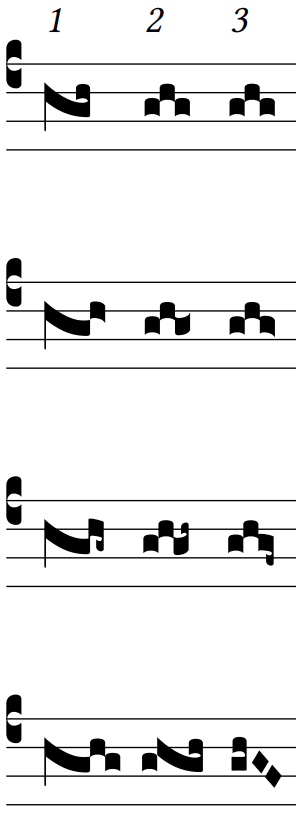Slanted Punctum?
-
Hi all,
Could anyone shed some light on how these slanted punctums are to be sung? This chant seems to be identical to some of the Psalmus Alleluiaticus in the Graduale Simplex, except that in the Simplex there is a descending liquescent note on the 'lu' syllable in 'Alleluia'. Does this slanted punctum serve the same function as a liquescent note?
 Screenshot 2024-01-04 at 9.31.28 AM.png1294 x 450 - 557K
Screenshot 2024-01-04 at 9.31.28 AM.png1294 x 450 - 557K -
I think so? The foreword to the Liber Hymnarius notes two kinds of liquescents: figurae auctae, such as this, which are elongated, and figurae deminutae, which are shortened. For a translation of the foreword with a guide to these neumes, see pp17-18 of this PDF.
-
Yes, it's an augmentative liquescent note, more specifically a descending augmentative liquescent note, perhaps better called simply a unison cephalicus. The liquescent notes of the manuscripts hold a key to the correct rhythm, which will help you cut through a lot of nonsense claims about what requires conjecture and what doesn't. The interchangeability of
1. plain porrectus=augmentative liquescent porrectus=diminutive liquescent porrectus flexus=plain porrectus flexus,
2. plain torculus=ascending augmentative liquescent torculus=diminutive liquescent torculus resupinus=plain torculus resupinus, and
3. plain torculus=descending augmentative liquescent torculus=diminutive liquescent pes subbipunctis=plain pes subbipunctis
reveals that the ordinary porrectus and torculus are short-short-long, not entirely short. All twelve figures have the same duration, two beats.

 Screenshot 2024-01-04 115200.png296 x 815 - 19K
Screenshot 2024-01-04 115200.png296 x 815 - 19K
Welcome to the MusicaSacra Forum!
To participate in the discussions on Catholic church music, sign in or register as a forum member, The forum is a project of the Church Music Association of America.
Categories
- All Discussions21,103
- General Music Discussion8,216
- Job Openings197
- Management of Music Programs850
- Choral Matters533
- Church Documents and Rubrics524
- CMAA Notes302
- Events716
- For Newcomers: Read First26
- Sacred Polyphony546
- Hymnody872
- Gregorian Chant: General2,697
- ↳ Graduale Romanum and Liber Usualis368
- ↳ Graduale Simplex60
- ↳ Semiology63
- Vernacular Plainsong696
- Anglican Use and Anglican Chant68
- Organ, Other Instruments and Repertoire435
- New Composition/Works in Progress1,290
- Recordings230
- Music for Hispanic Ministry159
- Music Education: Children211
- Music Education: General222
- News Items245
- Positions Wanted2
- General Discussion: Catholicism739
- Amusements177
- General Discussion1,033
- Opinions117
